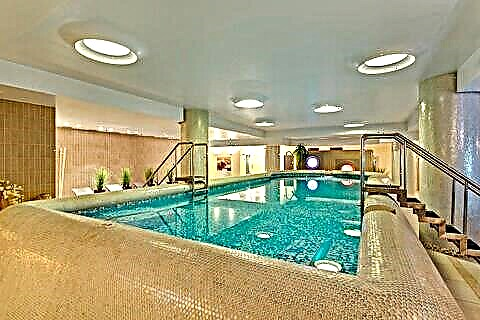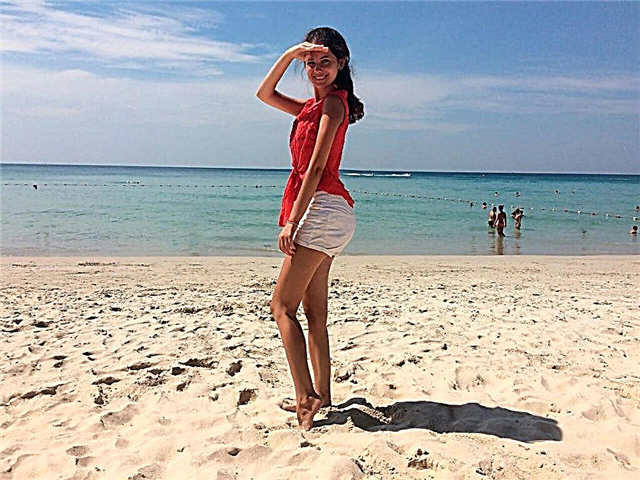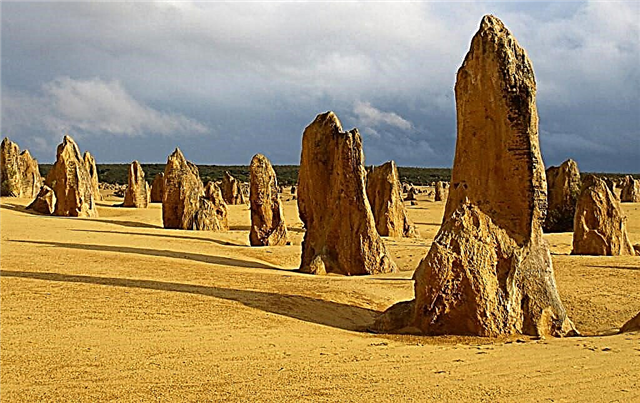Berlin's second largest park is a witness to many events that took place in Germany and Europe over the course of a century. Sprawling on the river bank of the Spree, he remembers both calm serene times, and exciting rallies of anti-fascists, the inspired speeches of Clara Zetkin, violent episodes of the Second World War and the collapse of Hitler's plans. Nowadays Treptower Park in the imagination of the whole world is associated with the Memorial to Soviet soldiers who liberated Europe from the Nazi plague.
History of the famous Berlin park

Even F.I.Tyutchev, being in the diplomatic service in Germany, noted how much attention the Germans pay to gardens and other green spaces, how they carefully preserve the plant world and increase it. Such was Gustav Mayer, according to whose project Treptower Park was created on the site of the former Boucher apple orchard. The talented designer, who cares about the prosperity of the city, planned the unique territory of the future park and put a lot of effort into making the project a reality. He did not live to see the opening of the park in 1888, taking part only in its foundation, but Mayer's landscape design was completely preserved. Already in the 50s of the 20th century, a magnificent garden of roses (25 thousand bushes) and sunflower was laid.
Treptower Park - a favorite place of leisure

Beautiful alleys, ponds, fountains, a rose garden, sports grounds are located here in accordance with the project of the landscape engineer. As a sign of grateful memory, his bust, with his head raised, as if peering into the park perspective, is installed under the canopy of trees, in a cozy corner of one of the alleys. After the opening, the townspeople immediately fell in love with the park, where you can walk under the shade of spreading lindens and oaks, take a boat ride on the Spree, eat ice cream in a cafe, feed fish in a pond. Various competitions and contests were organized on the sports grounds. Revolutionary-minded fighters for freedom and justice gathered here, speeches of German Marxists were heard, the phenimist-minded Clara Zetkin proclaimed the idea of holding Women's Day.
It is no coincidence that it was here that a place was chosen to perpetuate the grateful memory of the Soviet soldiers-liberators who cleansed Europe of the vices of fascism.
Berlin WelcomeCard: travel, discounts and travel guide
Berlin: 24- or 48-Hour Hop-On Hop-Off Bus Tour
Fast Track Ticket for TV Tower
Priority Entrance: Berlin TV Tower Window Seating
Skip-the-line: tickets to the Pergamon Museum
Coffee at the Käfer restaurant on the roof of the Reichstag
Panoramapunkt Observation Deck Ticket
Berlin Museum Pass: 3-Day Pass to 30+ Museums
Soldier Memorial

Created by the joint efforts of architects, sculptors and designers, the memorial complex in honor of the Russian soldier is the largest and most majestic military monument outside of Russia. In terms of worldwide fame and scale, it is not inferior to the Mamaev Kurgan memorial in Volgograd (formerly Stalingrad). Treptower Park is a sacred place for both Russians and Europeans, because almost 7,000 Soviet soldiers who died in the battles for Berlin are buried in its land. Where, if not here, above the sacrificial ashes of the saviors of a foreign country, is a grandiose structure destined to stand, embodying in granite the ideas of humanism and the victory of good over evil ?!
A brief history of the creation of the Memorial in Treptower Park

When the site of the complex was approved, the government of the USSR promulgated a decree on the competitive creation of the best project, as a result of which were the works of the architect Yakov Belopoltsev and the young sculptor Yevgeny Vuchetich. Large-scale work began on the selected site of the park and on the sculptural creations of the memorial. 60 sculptors from Germany, 200 masons, 1200 ordinary workers were mobilized. In the construction of the memorial, granite from the former Nazi Reich Chancellery was widely used. For the main sculpture of a Soviet soldier, with a sword in one hand and a little girl in the other, among the SA soldiers, Vuchetich chose a prototype of a warrior in the person of Sergeant Nikolai Masalov, who actually saved a German girl who was in a tragic situation during the shelling.
History of the Monument to the Liberator Soldier

A three-year-old child cried over his murdered mother, and the soldiers heard this sorrowful cry coming from the destroyed house in the intervals between artillery volleys. Masalov, according to the memoirs of Marshal Chuikov, at the risk of being killed, rushed into the ruins and pulled out the trembling girl. At the time of the rescue operation, he was wounded. In the memoirs of the fighters who liberated Berlin, such cases were repeatedly mentioned, so the impressive monument to the warrior-savior of children is fully justified. Two more athletic men served as the sculptor in kind: Ivan Odarchenko and Viktor Gunaz, a German girl and the daughter of the commandant of Berlin, Sveta Kotikova, who later replaced her.
Sculptural symbols of the main monument

The Memorial to the Soldier-Liberator is a symbol of a courageous soldier, a generalized image of a humane defender who is ready to sacrifice his life for the sake of a child's life. The gesture of a soldier who nailed the fascist swastika with a sword, like Saint George, piercing the treacherous Serpent with a spear, is also symbolic. Moreover, the sculptor sculpted the sword by analogy with the original sword of Prince Vsevolod of Pskov, who won many victories over enemies. On his sword, which has survived to this day, the inscription is embossed: "I will not give up my honor to anyone." Vuchetich chose the princely sword, despite objections, as a symbol of Russian weapons, reliable protection of his native land, remembering the catch phrase: "Whoever comes to us with a sword will die by the sword." The helpless figure of a girl, trustingly clinging to the broad chest of a mighty warrior, who is called upon to ensure the cloudless happiness of all children, regardless of nationality, is also symbolic.
The monument is erected on a burial mound, on a high white pedestal, with a Room of Memory and Sorrow located inside, in which there is a scarlet-colored velvet-bound parchment tome with the names of all those buried in the mass grave.
Unique interiors of the Memorial Room

The walls of the memorial room are covered with mosaic paintings depicting representatives of the fraternal republics laying commemorative wreaths at the graves of dead soldiers of different nationalities. But the room is always full of natural wreaths and flowers brought by Russian tourists and emigrants. The ceiling is decorated with a real work of applied art - a symbolic chandelier-Order of Victory, made of magnificent rubies and sparkling diamond crystals of rock crystal.
Sculptures-monuments of the memorial complex
A memorial field with 5 mass graves, marble sarcophagi opens to the gaze of a granite warrior; with eternal fire burning in granite bowls. The sad sarcophagi are engraved with excerpts from the statements of Stalin, the commander of the great Victory, which later provoked the objection of German officials. But their demand was considered unfounded and, according to the framework of the agreement, the words of the "father of nations" forever remained a spiritual part of the memorial.

At the entrance there is a symbolic gate in the form of 2 half-let down banners made of red granite, under which there are sculptural images of a young and an old soldier frozen in a mournful kneeling position.
In front of the entrance there is an expressive sculpture "The Grieving Mother", looking at which tears well up in the eyes: so much hopeless grief and motherly love is captured in the stunningly living figure of a woman with a mournful head bowed.She "sits" with one hand to her heart, and the other rests on a pedestal, as if looking for support in order to adequately survive the grievous loss of her sons. The “granite mother” disturbing the soul symbolizes all the mothers of the world, whose sons died in wars. An alley of Russian birches stretches on both sides of the memorial to the Soldier-Liberator as a symbolic link between the mother and the soldier-son.
 The sculpture of a mourning Soviet soldier is located on a pedestal of white granite slabs against the background of a red granite obelisk. In the bronze figure of a warrior kneeling; in the lowered head, the removed helmet, one can feel sadness for the fallen comrades and a mournful protest against the cruel senselessness of the war. But in the firm gesture of his hand, squeezing the lowered machine gun, in the whole courageous figure and inner restraint, one can feel the potential of force that can be reborn if necessary.
The sculpture of a mourning Soviet soldier is located on a pedestal of white granite slabs against the background of a red granite obelisk. In the bronze figure of a warrior kneeling; in the lowered head, the removed helmet, one can feel sadness for the fallen comrades and a mournful protest against the cruel senselessness of the war. But in the firm gesture of his hand, squeezing the lowered machine gun, in the whole courageous figure and inner restraint, one can feel the potential of force that can be reborn if necessary.
Memorial status

The grand opening of the grandiose Memorial Complex took place on the eve of Victory Day on May 9, 1949 in the presence of representatives of the official authorities of the Soviet Union and Germany, participants in the liberation of Berlin. Hundreds of Berliners came that day to Treptower Park to bow to the ingenious sculptural statues that embodied the tragedy of war and the greatness of Victory. Soon, an agreement was concluded between the states without a statute of limitations, according to which the memorial was transferred under the jurisdiction of the authorities of Berlin.
agreements oblige them to follow the proper order, carry out the necessary restoration work and not change anything on the memorial square without agreement with the representatives of the USSR. Not so long ago, a monument to the soldier-liberator was restored, ideal order is maintained around. Now, on memorable dates, there are mainly Russians, Jews living in Germany, Russian tourists and anti-fascists from all over the world. When visiting the Memorial, the words of Robert Rozhdestvensky come to mind: "People, remember, in years, in centuries, remember that this will never happen again, remember!"
Treptower Park today

It continues to live its measured life: in spring, summer and early autumn, attractions still work here, tourists and local public stroll along the cozy alleys. Parents come with children, for whom a playground with dizzying slides, entertaining teremkas and other attractions is equipped. There are many who want to take boat trips on the water surface of the Spree: boats are rented at the park's boat station.
Archenhold Observatory
and Berliners enjoy visiting the local Archenhold Observatory, where a powerful telescope with strong lenses is installed. This is the oldest and largest public observatory in Berlin, the opening of which was timed to coincide with the traveling industrial exhibition on May 1, 1896. At first it was a wooden structure with a telescope housed in it. In 1908, the dilapidated building was removed and a solid building of classical architecture of impressive size was built.

Einstein's first lecture on the theory of relativity took place on June 2, 1915. Later, the observatory was transformed due to the attached buildings of the planetarium, lecture hall and educational buildings into a whole complex, equipped with modern equipment. Together with the German Technical Museum, the observatory conducts educational and entertainment events, public lectures, and extramural planetary travel.
Music Festival in Treptower Park
The American alternative music festival Lollapalooza, which was born in 1991 in Chicago, is due to take place in Treptower Park on September 10-11, 2016. A year ago, it was held on the empty grounds of Tempelhof Airport. Due to the influx of refugees, the inoperative air terminal building was given to them, so Treptow Park was chosen as the venue for the festival.
Taking into account the concerns of the Russian Foreign Ministry in this regard, the organizers of the festival will take measures to protect the Memorial from vandalism and desecration: its territory will be fenced off with a high fence. The park has repeatedly hosted large-scale mass events that did not harm the holy place for Russians. I would like to believe that the upcoming festival will become an interesting, joyful event for everyone without negative consequences.

How to get to the park
You can get to the park:
- by train routes S 7, S 9 - stop Ostkreuz, with a change to the ring line to the stop. Treptow park
- by buses 166, 365, 265 to Pushkinskaya alley, from there on foot 10 minutes
- by boat on the Spree from the railway station for 5 euros
On foot from the center of Berlin to the park - half an hour.











